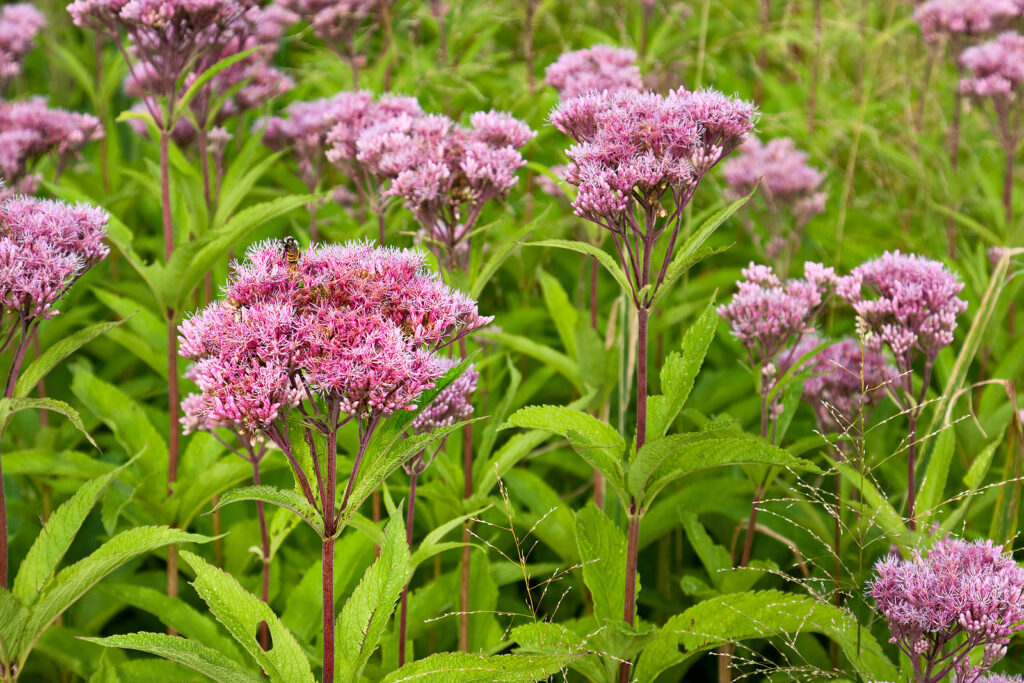Eupatorium–often called Joe Pye weed–is a good choice for boggy soils or informal gardens. This upright perennial has coarse green foliage on tall purple-flushed stems and large domed, purple-pink fluffy flower heads from late summer to early fall.
Eupatorium is a large plant; it can grow to 6 feet tall (2m) or more. The blossoms are tiny but are borne in large, loose clusters that suggest puffs of smoke. Lance-shaped leaves appear in whorls
Eupatorium grows best in good, moist soil. It is among the few perennials that can thrive in boggy soil alongside water.
Eupatorium is a genus of about 40 species of annual and perennials native to temperate and tropical regions in Europe, Africa, Asia, and North and South America.

Get to know Eupatorium
- Plant type: Perennial
- Growing Zones and range: Zones 3 to 10
- Hardiness: Hardy to -30°F (-34°C)
- Height and width: 4 to 7 feet (1.2-2.1m) tall and 3 feet (1m) wide or wider
- Foliage: Usually toothed and dissected but sometimes entire leaves.
- Flowers: Tubular flowers are borne in clusters on tall, stately plants.
- Flower colors: White, pink, purple, mauve
- Bloom time: Late summer or early fall; seed head remains in winter
- Uses: Attracts butterflies; mass plants; combine with ornamental grasses and Autumn Joy sedum
- Common name: Joe-Pye Weed
- Botanical name: Eupatorium purpureum
- Family: Asteraceae
- Origin: Temperate and tropical regions in Europe, Africa, Asia, and North and South America
Where to plant Eupatorium
- Plant Eupatorium in full sun or partial shade; too much shade will cause stems to flop over.
- Grow Eupatorium weed in humus-rich, moist soil. Eupatorium will tolerate wet soil.
Eupatorium uses and companions
- Use Eupatorium in large-scale borders, bog, and butterfly gardens, and in meadows and naturalistic landscapes.
- Good garden companions for Eupatorium include Hibiscus moscheutos, Iris, Ligularia, Lythrum.

When to plant Eupatorium
- Set established Eupatorium in the garden in spring.
Planting and spacing Eupatorium
- Space Eupatorium 3 feet (1m) apart.
- Sow seed 1/8 inch deep.
How to water and feed Eupatorium
- Eupatorium needs ample moisture,
- Give Eupatorium occasional all-purpose fertilizer.
Eupatorium care
- Pinch plants back in midsummer to control height.
- Mulch around plants to conserve soil moisture.
- Clumps of Eupatorium can be difficult to manage.
- Plants seldom need division.
Eupatorium pests and diseases
- Eupatorium is susceptible to mildew, white smut, Cercospora, and Septoria leaf spot.
- Snails and slugs can attack plants.
Eupatorium propagation
- Sow seed in spring.
- Eupatorium seeds require 30 days of cold stratification; afterward, seeds will germinate in 14 to 21 days at 70° to 80°F (21°-27°C).
- Divide hardy species and root softwood cutting of tender species in spring.
Eupatorium varieties to grow
- Eupatorium coelestinumm, hardy ageratum: grows to 3 feet tall with broad clusters of fluffy blue flowers; feely spreading.
- E. maculatum, joe pye weed: Grows 4 to 7 feet tall with green stems spotted in purple; bears flat-topped 6-inch clusters of pale to dark purple flower; cultivars include ‘Atropurpureum has deep-purple stems and reddish-purple or white flowers.
- E. purpurem, Joe pye weed: grows to 6 feet tall with 6-inch clusters of pale rose-pink or purplish flowers in midsummer; leaves have a vanilla scent; ‘Gateway’ has bronze stems that bear large, light-colored blooms.















